Liverpool, Albert Dock. Refit for HMS Wallflower (K44)

3 May 1942. Abbekerk is still waiting for orders to leave Colombo. Meanwhile in England the corvette HMS Wallflower is getting a big overhaul after two years of intense convoy service. Her equipment is also modernised and that will prove to be a lifesaver for the Abbekerk crew four months down the line. A good reason to take a closer look at this vessel and its history.
In the years leading up to WWII England put great faith in Asdic, the predecessor of Sonar. These systems locate, through sound waves, submerged submarines so that they can be destroyed with depth charges. The faith in Asdic was so great that a substantial fleet of escort vessels was deemed unnecessary. Soon after the outbreak of the war it proved less than a cure-all. The U-boats attacked mostly at night on the surface and there Asdic couldn’t see them. And so England was forced to – just as in WWI- introduce a convoy system to protect the merchant ships and secure the supply of England. They were now faced with a shortage of vessels to protect the convoys and fight submarines.
The (short term) solution: The Flower Class corvettes. A small warship of simple design and based on proven techniques. They could be built quickly at small shipyards all along the coast and be manned and sailed by crews without very specialized training. In 1942 the Flower Class corvette, manned by Royal Navy Reserves (RNR) and often under the command of a merchant navy captain, is the backbone of the convoy escorts in the Atlantic. The small vessels are named after flowers: Violet, Snowberry, Bittersweet- and in K44’s case HMS Wallflower.

Corvettes were small en very uncomfortable in the rough North Atlantic. HMS Bittersweet (K138)
(Source: Pinterest)
Rugged and seaworthy as they are the corvette is designed for short patrols along the coast and they proved to be highly uncomfortable for the crew during the long journeys on the cold and rough Atlantic. Besides that, they are just lightly armed with one 4 inch canon and one anti-aircraft gun. But with 70 depth charges on board she is extremely dangerous for submarines. She is powered by a classic ‘triple expansion’ steam engine which gives her a maximum speed, on Calm waters, of just 15 knots. Enough to keep up with the slower convoys, but not enough to chase submarines and rejoin the convoy later. And – not unimportant – slower than a submarine sailing on the surface.
In few years time 150 were built and 20 were sunk by torpedo’s or mines.
Back to the Wallflower which escorted more than 22 convoys during the last year. To a.o. Halifax (Canada), New York, Freetown, Gibraltar en Tokoradi (Ghana). She’s in the dock for months for maintenance and modernisations. As one of the first corvettes she is fitted with Radar. As Asdic uses sound waves in the water, Radar uses radio waves through the air. If the waves hit an object they reflect back and distance and direction can be measured.
England has a massive advantage over Germany with their Radar development. Germany thinks it’s impossible to build small enough Radar units to fit onto small vessels, let alone that the would be effective against a small target like a submarine. Nothing could be further from the truth. The English even develop a Radar to fit within a plane. This miscalculation will prove to be one of the biggest contributing factors to Germany finally losing the battle of the Atlantic in the end.
Wallflower is fitted with the Type 271 centimetric Radar, the first type which, under the right circumstances, could even detect something as small as a periscope. In the dark and in the mist and from a much larger distance than the human eye could ever do.
Next, two pages from the book Corvette and Submarine written by Max Sheen in which he is getting acquainted for the first time with Radar on the HMS Bluebell. ( thanks to Roy Terry, who’s father served on the Wallflower).
As Wallflower leaves port mid July to connect with convoy ON128 it is a nearly new ship and under the command of Lt. George Richard Greaves, RNR
Wallflower escorted 22 convoys between April 1941 and March 1942
| Date convoy sailed | Joined convoy as escort | Convoy No. | Left convoy | Date convoy arrived |
| 06/04/41 | 06/04/41 | OB 308 | 10/04/41 | 13/04/41 |
| 19/04/41 | 04/05/41 | SC 029 | 08/05/41 | 08/05/41 |
| 12/05/41 | 13/05/41 | OB 322 | 18/05/41 | 20/05/41 |
| 06/05/41 | 18/05/41 | HX 125A | 21/05/41 | 22/05/41 |
| 10/06/41 | 10/06/41 | OB 333 | 14/06/41 | 21/06/41 |
| 04/06/41 | 15/06/41 | HG 064 | 19/06/41 | 19/06/41 |
| 08/06/41 | 29/06/41 | SL 077 | 03/07/41 | 03/07/41 |
| 12/07/41 | 12/07/41 | OG 068 | 26/07/41 | 26/07/41 |
| 13/07/41 | 03/08/41 | SL 081 | 08/08/41 | 08/08/41 |
| 13/08/41 | 15/08/41 | OG 071 | 23/08/41 | 23/08/41 |
| 02/09/41 | 02/09/41 | HG 072 | 17/09/41 | 17/09/41 |
| 25/08/41 | 02/09/41 | SL 085 | 11/09/41 | 17/09/41 |
| 11/11/41 | 11/11/41 | ST 008 | 16/11/41 | 16/11/41 |
| 22/11/41 | 22/11/41 | ST 009 | 27/11/41 | 27/11/41 |
| 04/01/42 | 04/01/42 | SL 097 | 06/01/42 | 24/01/42 |
| 23/12/41 | 09/01/42 | OS 015 | 13/01/42 | 13/01/42 |
| 05/01/42 | 21/01/42 | OS 016 | 23/01/42 | 23/01/42 |
| 09/02/42 | 09/02/42 | SL 100 | 14/02/42 | 04/03/42 |
| 30/01/42 | 15/02/42 | OS 018 | 20/02/42 | 20/02/42 |
| 11/02/42 | 01/03/42 | OS 019 | 03/03/42 | 03/03/42 |
| 14/03/42 | 14/03/42 | SL 103 | 31/03/42 | 02/04/42 |

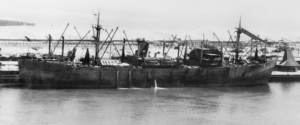
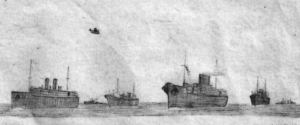
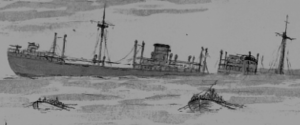
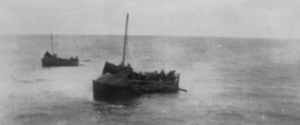
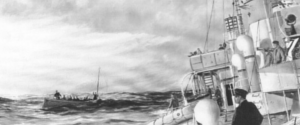
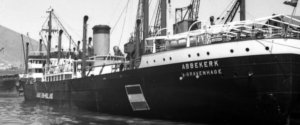







My father was Lt George Richard Greaves
He died in August 2018 aged 104
In 1944, Wallflower helped find and sink the U boat that sunk HMS Ganilly. I have a medal group from the Chief Engineman on Ganilly who went down with the ship on 5th July 1944 in the Channel..
Dear Harold,
I’m sorry to hear you are disappointed in the way I have translated the website.
The intention of this website is to keep the memory alive of all the men who sailed merchant ships and escorts during the war. As far as I know (and intended) , I have only spoken highly of the crew of HMS Wallflower. I can assure you that there is no intention to offend anybody.
As you probably noticed this is a Dutch website en the translation into English has been a major undertaking since the website consist of over 125 pages. I am very grateful to everyone who helped me to make the website – almost entirely – bilingual. But since I am no professional translator, nor historian, I’m fully dependent of English speaking readers to help me with typical English (British if you like) details about ranks, names, designations, names of army units and even names of arms. But also the finer details of the English/British language.
In the next major update of the website I will correct the error.
Peter
I am disappointed with use of England and English here. My father was a Scot and he served on HMS Wallflower…Britain and British please